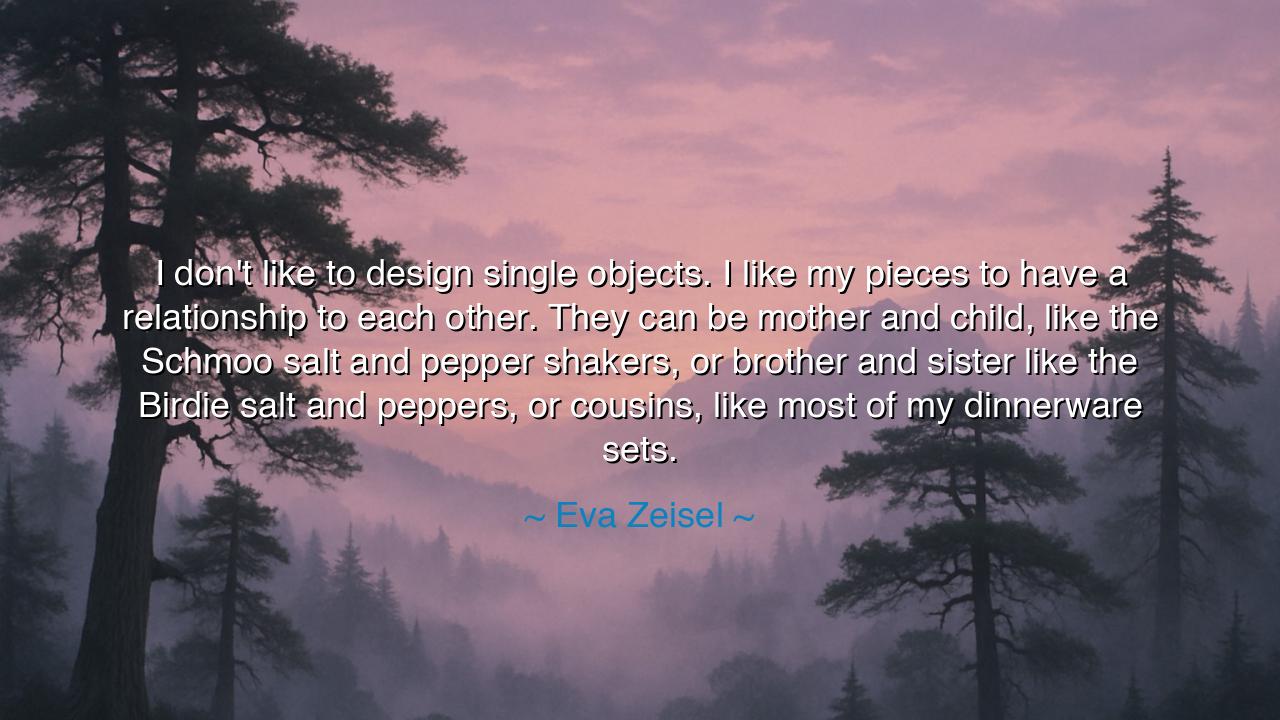
I don't like to design single objects. I like my pieces to have a
I don't like to design single objects. I like my pieces to have a relationship to each other. They can be mother and child, like the Schmoo salt and pepper shakers, or brother and sister like the Birdie salt and peppers, or cousins, like most of my dinnerware sets.






“I don’t like to design single objects. I like my pieces to have a relationship to each other. They can be mother and child, like the Schmoo salt and pepper shakers, or brother and sister like the Birdie salt and peppers, or cousins, like most of my dinnerware sets.” Thus spoke Eva Zeisel, the great Hungarian-born designer whose work transformed the ordinary into the poetic. Her words are not merely about ceramics or the crafting of form—they are about relationship, about connection, and about the deep truth that nothing in life, nor in art, truly exists in isolation. In her designs, as in her philosophy, Zeisel saw the world not as a collection of separate objects, but as a living family of forms—each one speaking softly to the other, each one completing the other’s story.
Zeisel’s quote was born from her lifelong devotion to “the playful search for beauty.” She believed that even the humblest object—a teacup, a bowl, a pair of shakers—could carry within it the spirit of tenderness and kinship. Her designs, such as her Schmoo and Birdie sets, were not lifeless tools, but companions—shapes that curved toward each other as though in affection. To her, an object should never stand alone, for solitude in design was unnatural, as solitude in life is sorrowful. Everything, she taught, gains its meaning in relation—in how it touches and is touched by what surrounds it.
This idea—of form as relationship—is ancient. The philosopher Aristotle once said that the whole is greater than the sum of its parts. So too did Zeisel understand that beauty blooms in connection, not in isolation. A single bowl may be graceful, but two bowls that curve toward one another—like friends in conversation—create harmony. A set of plates that echo each other’s contours becomes a symphony of quiet unity. The lesson she offers is profound: design is not the creation of objects, but the shaping of relationships between them.
The story of Zeisel’s life mirrors the wisdom of her art. She was imprisoned for sixteen months in Soviet Russia under false accusations of conspiracy—a time when all connection seemed lost, when she lived in silence and uncertainty. Yet even in her solitude, she did not break. She later said that her experience taught her the importance of warmth and humanity, of the bonds that make life bearable. When she returned to her work, her designs reflected that understanding: every curve, every gentle line was an act of reconciliation, a declaration that life and beauty must be interdependent. Her objects touched each other the way people ought to—gently, meaningfully, and with care.
In her metaphor of “mother and child,” “brother and sister,” and “cousins,” Zeisel also reveals a moral truth: that design, like family, is rooted in love. The way objects relate to one another mirrors the way we, too, must relate—with empathy, complementarity, and grace. A “mother and child” set speaks of nurture and protection; a “brother and sister” design speaks of balance and equality. Even her “cousin” dinnerware reflects diversity within harmony—the idea that difference can still belong within the same family of form. To design in this way is to echo the pattern of life itself: distinct parts joined by invisible threads of affection.
This philosophy extends far beyond the world of ceramics. In every field—in architecture, in business, in art, and in the building of communities—the principle of relationship-driven creation holds true. A city without connection between its parts becomes chaos; a company that neglects the bond between its people loses its soul. To create harmony, one must think relationally—each action, each piece, each idea considered as part of a greater whole. As Zeisel understood, beauty is not the triumph of the individual object, but the grace of coherence.
So, my listener, take this teaching to heart: create not in isolation, but in relationship. Whatever you build—be it art, family, or future—let each part be aware of the other. Let your actions curve toward others like Zeisel’s forms—warm, intentional, and full of grace. Do not seek perfection in single achievements; seek harmony in how your life connects to those around you. For in the end, as Zeisel’s art teaches, it is not the solitary masterpiece that endures, but the family of forms—the chorus of relationships—that gives meaning to creation.
Thus, remember the wisdom of Eva Zeisel: that everything beautiful belongs to something greater than itself. The cup and the saucer, the mother and the child, the artist and the world—all are bound in one eternal design. To live, to love, to create—is to honor that connection, and in doing so, to make the ordinary divine.






AAdministratorAdministrator
Welcome, honored guests. Please leave a comment, we will respond soon